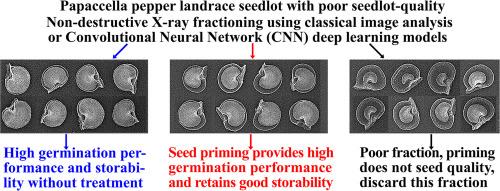应用x射线分选和激发技术提高了地方辣椒低质量种子组分的萌发性能
IF 4.2
2区 农林科学
Q1 HORTICULTURE
引用次数: 0
摘要
包括辣椒在内的蔬菜生产需要高质量的种子,这对种子储存、发芽性能和作物生产都很重要。许多蔬菜地方品种,如来自意大利南部坎帕尼亚地区的黄色Papaccella辣椒品种(PY),其种子质量较低。利用一个种子质量较差的PY种子块,我们证明了通过x射线成像、鉴定的中等质量部分的靶向种子启动以及消除鉴定的低质量部分相结合,可以将其提高到高质量水平。采用非破坏性软x射线成像技术,结合经典(ImageJ)和卷积神经网络(CNN)深度学习模型,根据胚+胚乳(EE)区与整个种子的相对比例,对PY辣椒种子进行识别和分类。对这些形态上不同的群体的发芽性能和老化弹性进行比较分析表明,它们代表了生理上不同的品质群体。组1种子(EE > 90%)为优质种子,性能优异,不需要任何采后处理。2组种子为优质种子(EE 75 ~ 90%),采后启动处理使其萌发性能提高到1组的水平。第3组(EE< 75%)、第4组(EE异常)为低质量种子,无法改良,但x线影像可识别并丢弃。我们认为所建立的方法和标准可以很容易地转移到其他园艺物种的苗区。本文章由计算机程序翻译,如有差异,请以英文原文为准。

Application of X-ray sorting and priming improves the germination performance of low-quality seed fractions of the Papaccella pepper landrace
High seed quality, important for seed storage, germination performance and crop production, is required for vegetable production including pepper (Capsicum annum). Many vegetable landraces such as the yellow Papaccella pepper cultivar (PY) from the Campania region in South Italy, have low seedlot quality. Using a PY seedlot with poor seed quality we demonstrate that it can be improved to high-quality level by a combination of X-ray imaging, targeted seed priming of identified medium-quality fractions, combined with elimination of the identified low-quality fractions. Non-destructive soft X-ray imaging combined with classical (ImageJ) and Convolutional Neural Network (CNN) deep learning models was used to identify and fractionate the PY pepper seedlot into distinct groups based on the relative proportion of the embryo+endosperm (EE) compartment in relation to the entire seed. Comparative analysis of these morphologically distinct groups for their germination performance and ageing resilience revealed that they represent physiologically distinct quality groups. Group 1 seeds (EE >90 %) were high-quality seeds with excellent performance which did not require any post-harvest treatment. Group 2 seeds (EE 75–90 %) were good quality seeds for which a post-harvest priming treatment improved their germination performance to the level of group 1. Groups 3 (EE<75 %), 4 (EE abnormalities) were low-quality seeds which can’t be improved, but can be identified by X-ray imaging and discarded. We propose that the established method and criteria can be transferred easily to seedlots of other horticultural species.
求助全文
通过发布文献求助,成功后即可免费获取论文全文。
去求助
来源期刊

Scientia Horticulturae
农林科学-园艺
CiteScore
8.60
自引率
4.70%
发文量
796
审稿时长
47 days
期刊介绍:
Scientia Horticulturae is an international journal publishing research related to horticultural crops. Articles in the journal deal with open or protected production of vegetables, fruits, edible fungi and ornamentals under temperate, subtropical and tropical conditions. Papers in related areas (biochemistry, micropropagation, soil science, plant breeding, plant physiology, phytopathology, etc.) are considered, if they contain information of direct significance to horticulture. Papers on the technical aspects of horticulture (engineering, crop processing, storage, transport etc.) are accepted for publication only if they relate directly to the living product. In the case of plantation crops, those yielding a product that may be used fresh (e.g. tropical vegetables, citrus, bananas, and other fruits) will be considered, while those papers describing the processing of the product (e.g. rubber, tobacco, and quinine) will not. The scope of the journal includes all horticultural crops but does not include speciality crops such as, medicinal crops or forestry crops, such as bamboo. Basic molecular studies without any direct application in horticulture will not be considered for this journal.
 求助内容:
求助内容: 应助结果提醒方式:
应助结果提醒方式:


